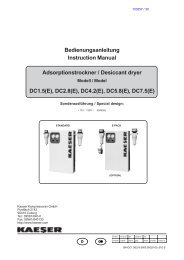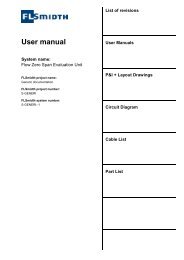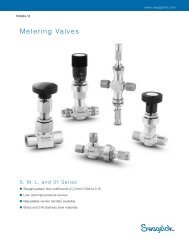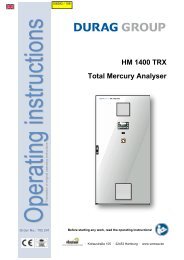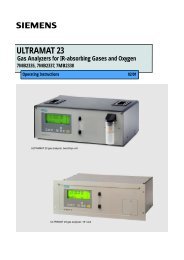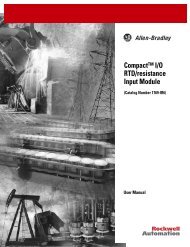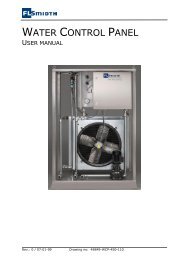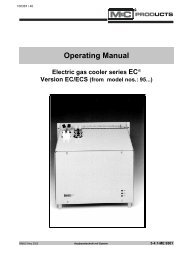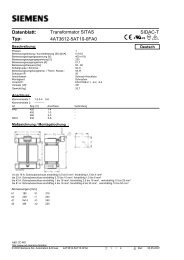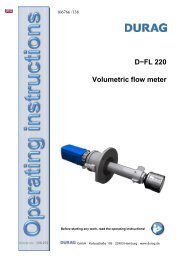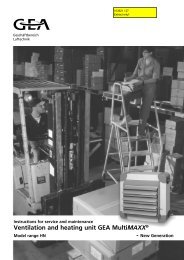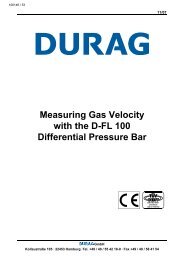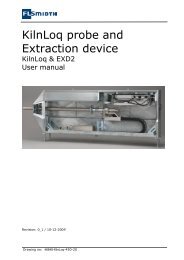Measuring Gas Velocity with the D-FL 100 Differential Pressure Bar
Measuring Gas Velocity with the D-FL 100 Differential Pressure Bar
Measuring Gas Velocity with the D-FL 100 Differential Pressure Bar
- No tags were found...
You also want an ePaper? Increase the reach of your titles
YUMPU automatically turns print PDFs into web optimized ePapers that Google loves.
D−<strong>FL</strong> <strong>100</strong> Seite 247. MaintenanceThe D-<strong>FL</strong> <strong>100</strong> is a low-maintenance system <strong>with</strong> long maintenance intervals. The maintenance scheduledepends on <strong>the</strong> application, and is generally several months (3 months as a rule of thumb). <strong>Pressure</strong>conditions, climatic and o<strong>the</strong>r ambient influences at <strong>the</strong> measuring site, and <strong>the</strong> gas being measured allaffect <strong>the</strong> maintenance schedule.Maintenance work should be performed in <strong>the</strong> following order:1. Adjust menu item Maintenance at <strong>the</strong> D-<strong>FL</strong> <strong>100</strong>-10 Display.Use <strong>the</strong> MOD key on <strong>the</strong> D-<strong>FL</strong> <strong>100</strong>-10 Display to select Stand by.2. Clean <strong>the</strong> exterior of <strong>the</strong> unit.3. Check <strong>the</strong> differential pressure bar and <strong>the</strong> differential pressure transducer.Check exterior covers and <strong>the</strong> connections between differential pre ssure bar and transducer.4. Flush <strong>the</strong> measuring pipes.The pipes may need to be flushed, depending on application conditions. By changing <strong>the</strong> setting of<strong>the</strong> switching valve, purge air is directed separately to <strong>the</strong> different pressure lines (see Fig. 4 forswitching valve settings).5. Clean <strong>the</strong> differential pressure bar.Under extreme application conditions, when a simple flushing of <strong>the</strong> pressure lines would not besufficient, <strong>the</strong> differential pressure bar must be cleaned <strong>with</strong> a cloth or a brush. The differentialpressure bar must first be disconnected from <strong>the</strong> transducer and removed from <strong>the</strong> duct/stack. Themaintenance intervals need to be shorter under such extreme application conditions.6. Make a zero point adjustment of <strong>the</strong> differential pressure transducer.The two wires on <strong>the</strong> transducer are cross-wired via <strong>the</strong> switching valve, and <strong>the</strong> exhaust screwsare opened briefly and shut again (pressure equalization at transducer).Remove <strong>the</strong> housing cover from <strong>the</strong> transducer to monitor <strong>the</strong> electric current signal on <strong>the</strong> display.The current output must now be 4.00 mA. If it is not, a zero point adjustment must be made.Remove both screws from <strong>the</strong> protective cover and remove <strong>the</strong> cover. Use <strong>the</strong> M key to proceed topoint 7 and perform <strong>the</strong> adjustment. Press and simultaneously for about 2 seconds. Thedisplay should now show 4.00 mA; if it does not, repeat <strong>the</strong> adjustment.7. Switch on <strong>the</strong> D-<strong>FL</strong> <strong>100</strong>-10 Display.Use <strong>the</strong> MOD key on <strong>the</strong> D-<strong>FL</strong> <strong>100</strong>-10 Display to proceed <strong>with</strong> <strong>the</strong> measuring process.GmbH



